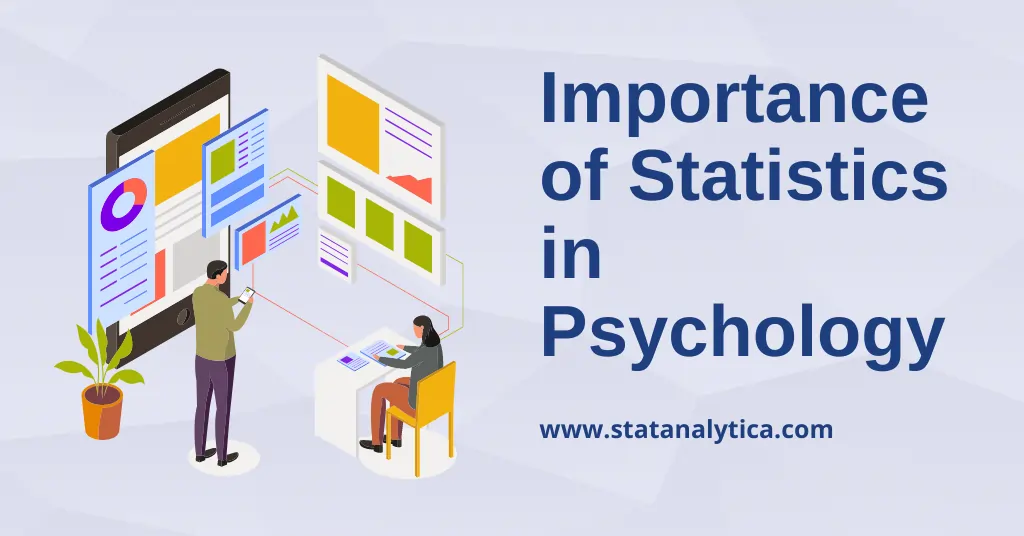If you want to know what is the importance of statistics in psychology, then you are at the right place. Many psychology students are surprised and sometimes disappointed to learn that statistics courses are required for graduation in their major. Yes, statistics courses are required in almost all psychology programs.
Not only will you need to take at least one or two statistics courses, but you will also most likely encounter statistics in many of your other classes, particularly those involving experimental design or research methods. In other words, you must not only be able to pass a statistics class, but you must also understand statistics.
However, if you are looking for a statistics assignment helper, don’t worry you can get the best statistics assignment help from our experts. So, what are you waiting for get help now!
So, let’s first know what statistics in psychology is, and then we further move to the importance of statistics in psychology.
What is Statistics in Psychology?
Table of Contents
Statistics in Psychology – Applying formulas, theorems, numbers, and laws to psychology is known as psychological statistics. Statistical methods for psychology include statistical theory development and application, as well as methods for modeling psychological data.
What Are The Types Of Statistics In Psychology?
Here in this section, we will tell you four main types, which are as follows:
1. Descriptive Statistics
Descriptive Statistics is used to describe and summarize data in psychology. This includes measures of central tendency (mean, median, mode) and variability (range, variance, standard deviation).
2. Inferential Statistics
Inferential statistics is used to draw conclusions and make predictions about a larger population based on a smaller sample of data.
This includes
- Hypothesis testing
- Confidence intervals
- Effect sizes
3. Correlational Analysis
Correlational analysis examines the relationship between two or more variables, such as the strength and direction of the relationship between depression and anxiety.
4. Experimental Design
Experimental design is used to investigate cause-and-effect relationships, such as whether a new therapy is effective for treating depression compared to a placebo.
What is the Importance of Statistics in Psychology: Top 3
First, think about the importance of statistics in real life. Statistics enables us to make sense of and analyze vast amounts of data. Consider how much data you encounter in a single day. How many hours did you sleep last night? How many of your classmates ate breakfast this morning? How many people live within a mile of your house? We can organize and interpret all of this information in a meaningful way by using statistics.
On the other hand, in psychology, we also organize a great amount of data. How can changes in one variable affect another variable? Or can we somehow measure that relationship? And many more. As a result, statistics allow us to answer these types of data.
Below are the top 3 importance of statistics in psychology in real life:
1. Organize Data
If you are dealing with an enormous amount of data, then it is quite obvious to become overwhelmed. Statistics enable psychologists to present data in more understandable ways.
On the other hand, visual displays such as graphs, pie charts, and scatterplots help researchers gain a better understanding of data and spot patterns that they might miss. As a result, organizing data comes under the importance of statistics in psychology.
2. Describe Data
Think about what happens when researchers assemble a large amount of data about a group of people. The Census Bureau of the USA is a great example of it. We can accurately describe the information gathered using statistics in an understandable manner.
On the other hand, statistics are used to summarise what already exists in a given population, such as the number of men and women, children, and people who are currently employed.
3. Make Inferences Based on Data
With the help of inference statistics, researchers can gather the information about a given sample or population. On the other hand, psychologists use the data that they have collected to test a hypothesis. Or researchers can use statistical analysis to determine the possibility that a hypothesis will be accepted or rejected.
Well, the question that arises here is how statistics help a researcher, let’s find out the answer.
Read More
- 75+ Realistic Statistics Project Ideas For Students To Score A+
- Top 60 Trending Statistics Research Topics for Students
- Top 26 Uses Of Statistics In Our Day to Day Life
How Statistics Help a Researcher in the Field of Psychology
Statistics is required for conducting research in psychology and social sciences. It benefits the researcher in the following ways:
- The most important aspect of a study is selecting a sample representing the study’s population; statistics are used to determine the sample size.
- What kinds of information are required for the study?
- What methods will be used to analyze the data?
- How to conclude data analysis
Statistics allows a researcher to design, describe, analyze, and draw conclusions from his research in this way.
What Is The Application Of Psychology In Statistics?
Psychology and statistics are interrelated fields, with psychology providing insights into human behavior and statistics providing the tools to analyze and interpret data. Here are seven applications of psychology in statistics:
1. Survey Design
Psychological research can help design surveys that measure specific attitudes, behaviors, and traits to collect meaningful data.
2. Psychometric Testing
Psychometrics is the scientific study of measuring psychological traits, which often involves the use of statistical methods to analyze data. If you want to attain a doctorate in psychology, this is a process with which you’ll become intimately familiar, as this type of testing could be used to underpin the thesis of your entire degree.
3. Experimentation
Psychology experiments often require statistical analysis to determine the significance of results.
4. Regression Analysis
This statistical method helps identify relationships between variables and can be used to predict outcomes based on specific predictors.
5. Meta Analysis
This method is used to combine and analyze results from multiple studies to identify common patterns or trends. So, if you want to analyze the result of multiple studies, then you know what to use.
7. Factor Analysis
This statistical method is used to identify underlying factors that explain the relationship between multiple variables.
8. Data Visualisation
Psychologists can use statistics to create visual representations of data, such as graphs and charts, to understand patterns and relationships in the data better.
So, here are seven applications of psychology in statistics that you can use to do statistical analysis.
Some Limitations of the Use of Statistics
If there is a good thing about something, then there is a bad thing also. Some of the limitations of the uses of statistics are as follows:
1. As you already know that statistics is a branch of mathematics, but it still has its limitations. The main drawback of statistics is that it provides an estimate of the data, not accurate results.
2. Furthermore, it is concerned with social sciences, which are concerned with humans. We cannot predict human behavior with 100% accuracy, but it provides the most accurate findings.
3. Statistics only work with quantitative data, which is made up of numbers. To make statistics work with qualitative data, we must first convert the data to numbers.
4. Statistics only works with a group of people which means that statistics does not work with an individual.
5. Lastly, sometimes, the result of statistics may lead the reader to some confusing information. This means that statistics is hard for those who do not know how to read information.
Conclusion
Statistics is the branch of mathematics dealing with the organization, analysis, and interpretation of a collection of numbers. Statistics are essential in psychology for conducting research.
On the other hand, in this post, we discuss some of the importance of statistics in psychology and some of the limitations of statistics. I hope you get your answer by reading this post.
FAQs
Q1. What type of statistics is used in psychology?
There are two types of statistics that are used in statistics which are as follows: Descriptive statistics and Inferential statistics. Descriptive statistics describe and summarise data, whereas inferential statistics allows researchers to conclude the data described by descriptive statistics.
Q2. What is the role of statistics in psychology?
Statistics play multiple roles in psychology. It can predict what is most likely to happen, what is most likely to occur, and what is typical or normal for a specific group. On the other hand, it can also help a psychologist make sense of the large amount of data gathered through research. These are some of the roles of statistics in psychology.


